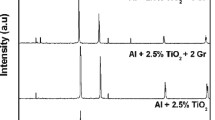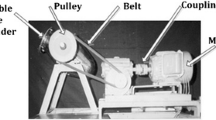Abstract
The present technical work reports on the workability performance along with the consolidation behavior of aluminum (Al) and Al–5% silicon carbide (SiC) powder metallurgy composites during cold compaction. An experimental work has been carried out to investigate the powder compaction behavior of Al–SiC metal matrix composites. SiC of particle sizes 120, 75, and 45 μm has been pre-alloyed with Al powders of particle size ranging from −37 to 75 μm. Various particle size additives of SiC have been used as a second-phase particle in this work with the intension of predicting the mechanical and metallurgical properties of the metal matrix composites studied. The pressure applied for the preparation of compacts have been considered as 220–260 kN in order to prepare the samples of heights in the range of 30 to 32 mm, and the diameter of the compacted sample was 26.11 mm. The densification during compaction is measured by means of the presence of voids in the compacts applying the mass constancy principle. The effect of particle size on the metal matrix composites proposed has been completely investigated under two different stress state conditions such as plane and triaxial.
Similar content being viewed by others
References
Narayanasamy R, Ramesh T, Pandey KS (2005) Some aspects on workability of aluminium–iron powder metallurgy composite during cold upsetting. Mater Sci Eng A 391:418–426
Narayanasamy R, Ramesh T, Pandey KS (2006) Some aspects on strain hardening behaviour in three dimensions of aluminium–iron powder metallurgy composite during cold upsetting. Mater Des 27:640–650
Narayanasamy R, Pandey KS (1998) Some aspects of work hardening in sintered aluminium–iron composite preforms during cold axial forming. J Mater Process Technol 84:136–142
Narayanasamy R, Pandey KS (1997) Salient features in the cold upset-forming of sintered aluminum–3.5% alumina powder composite performs. J Mater Process Technol 72:201–207
Narayanasamy R, Pandey KS (1997) Phenomenon of barrelling in aluminium solid cylinders during cold upset-forming. J Mater Process Technol 70:17–21
Narayanasamy R, Senthilkumar V, Pandey KS (2008) Some aspects of workability studies on sintered high strength P/M steel composite preforms of varying TiC contents during hot forging. J Mater Sci 43:102–116
Narayanasamy R, Senthilkumar V, Pandey KS (2006) Workability studies on powder metallurgy pure iron preforms during hot forging under triaxial stress state condition. Int J Mech Mater Des 3:175–184
Narayanasamy R, Senthilkumar V, Pandey KS (2006) Some aspects of workability studies on P/M sintered high strength 4% Titanium carbide composite steel performs during cold upsetting. Int J Mech Mater Des 3:39–57
Sridhar I, Fleck NA (2000) Yield behaviour of cold compacted composite powders. Acta Mater 48:3341–3352
Manisekar K, Narayanasamy R (2004) Phenomenon of barrelling in square billets of copper during cold upset forging. Journal of The Institution of Engineers, Singapore 44(4):172–176
Manisekar K, Narayanasamy R (2003) Phenomenon of barrelling in square billets of aluminium during cold upset forging. Int J Adv Manuf Technol 21:84–90
Manisekar K, Narayanasamy R (2007) Effect of friction on barrelling in square and rectangular billets of aluminium during cold upset forging. Mater Des 28:592–598
Malayappan S, Narayanasamy R (2004) An experimental analysis of upset forging of aluminium cylindrical billets considering the dissimilar frictional conditions at flat die surfaces. Int J Adv Manuf Technol 23:636–643
Malayappan S, Esakkimuthu G (2006) Barrelling of aluminium solid cylinders during cold upsetting with differential frictional conditions at the faces. Int J Adv Manuf Technol 29:41–48
Manisekar K, Narayanasamy R, Malayappan S (2006) Effect of friction on barrelling in square billets of aluminium during cold upset forging. Mater Des 27:147–155
Li Yong, Mohamed FA (1997) An investigation of creep behavior in an SiC–2124 Al composite. Acta Mater 45(11):4775–4785
Zhigang L, Yong L, Mohamed FA (2002) Creep and substructure in 5 vol.% SiC–2124 Al composite. Mater Sci Eng A332:330–342
Xiao BL, Fan jZ, Tian xF, Zhang wY, Shi lK (2005) Hot deformation and processing map of 15%SiCp/2009 Al composite. J Mater Sci 40:5757–5762
Chen K-H, Ge J-H, Liu H-W, Liu Y-Z (2000) Reactive processing and mechanical properties of Al/SiCp composite. J Cent South Univ Technol 7(1):1–3
Author information
Authors and Affiliations
Corresponding author
Rights and permissions
About this article
Cite this article
Ramesh, T., Prabhakar, M. & Narayanasamy, R. Workability studies on Al–5%SiC powder metallurgy composite during cold upsetting. Int J Adv Manuf Technol 44, 389–398 (2009). https://doi.org/10.1007/s00170-008-1880-z
Received:
Accepted:
Published:
Issue Date:
DOI: https://doi.org/10.1007/s00170-008-1880-z




